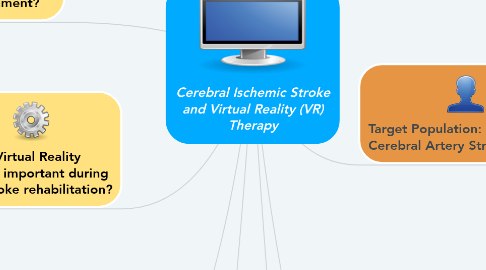
1. What is a Virtual Environment?
1.1. Can include or excludes robotic assistance. Studies examined excluded robotic assistance/resistance.
1.2. A type of user-computer interface that implements real time simulation of an activity environment allowing user interactions via multiple sensory modalities (1)
2. Why is Virtual Reality Therapy important during post-stroke rehabilitation?
2.1. Neurophysiological data suggest considerable amounts of practice are required to induce neuroplastic change and functional recovery (1)
2.1.1. Goal of Virtual Reality Therapy: increase patient practice (repetitions) by engaging multiple senses during the post-stroke recovery period
2.1.2. Traditional rehabilitation presents with a limitation: clients generally perform a very limited number of movement reps (1)
2.1.2.1. Also limited by financial, environmental and individual barriers (1)
3. Stroke Neurophysiology
3.1. What Neurons are Excited/Inhibited post-stroke?
3.1.1. Multiple short + long term changes in the brain post-stroke result in an imbalance of inhibitory and excitatory neurotransmitters (2)
3.1.1.1. GABA (inhibitory)
3.1.1.2. Glutamate (excitatory)
3.1.2. Long Term Potentiation due to downregulation of GABA activity (2)
3.1.3. An increase in NMDA receptors at binding sites of the cortex (2)
3.2. How does VR Therapy improve patient outcomes post-stroke?
3.2.1. Cerebral ischemic stroke causes motor dysfunction and deficits. VR Therapy helps these patients to increase the number of movement reps
3.2.2. Neurogenesis: The process of creating new neurons in the brain (4)
3.2.2.1. Neurogenesis can be excited or inhibited by different physiological and pathological conditions in certain brain regions (4):
3.2.2.1.1. Smoking
3.2.2.1.2. Physical Exercise
3.2.2.1.3. Stress
3.2.2.2. Mechanism of neurogenesis is still poorly understood (4)
3.2.2.2.1. Post stroke neurogenesis: starts days after stroke, maximizes around 3 months, and may last up to 12 months (4)
4. Ultimate Recommendations for Clinical Practice
4.1. In the absence of robotic assistance, VR Therapy appears relatively cost effective and safe for use (1,6)
4.2. VR Therapy can be used as an assistive device for post-stroke patients, improving ICF outcomes (1).
4.3. VR Therapy could serve as an alternative approach to help individuals struggling with motivation and will to exercise post-stroke by engaging multiple sensory pathways (1)
4.4. Since the main goal of conventional therapy post-stroke is to ensure many cycles of repetition are completed, increasing patient engagement through VR Therapy is a useful too for clinical practice (1,6).
4.5. Using a treadmill VR based system has shown small benefits for walking speed, balance and mobility in post stroke patients (6)
5. General Pathophysiology of Cerebral Ischemic Stroke
5.1. Ischemic damage affects neurons, astrocytes, pericytes, cerebral microvascular endothelium, and extracellular matrix of basal lamina (2)
5.2. Pathophysiology is complex: involves several factors including energy failure, loss of homeostasis, acidosis, increased calcium levels, excitotoxicity, and disruption of the blood-brain barrier, among others.
5.2.1. 2nd leading cause of mortality worldwide (5)
5.2.2. Ischemic Stroke = 85% of all strokes (5)
5.2.3. Certain populations of neurons more vulnerable to ischemia (5):
5.2.3.1. Hippocampus CA1 neurons vulnerable
5.2.3.2. Hippocampus Granule neurons resistant
5.2.4. All brain matter indefinitely sensitive to ischemia (5)
5.2.4.1. White matter more resilient than grey
5.3. Core brain tissue is exposed to dramatic flow reduction, mortally injured and undergoes cell death, forming the necrotic zone (5)
5.3.1. Necrotic zone surrounded by Ischemic Penumbra: a functionally silent but metabolically active portion of brain tissue (5)
5.3.1.1. This is the region which is potentially salvaged post-stroke
6. Target Population: Anterior Cerebral Artery Stroke patients
6.1. Cause
6.1.1. anterior cerebral artery that supplies oxygenated blood to sections of the frontal and parietal lobes is occluded, typically from atheroslerosis (3)
6.2. Motor deficits are varied
6.2.1. Affects frontal, prefrontal and supplementary cortex (3)
6.2.2. Symptoms involving the lower extremity contralateral to the infarct site are present in 86.3 to 90% of patients (3)
6.2.2.1. Lateral and anterior Corticospinal tracts
6.2.2.2. Lateral and anterior Spinothalamic tracts
6.3. Goal of treatment
6.3.1. The use of VR Therapy to optimize ACA stroke recovery by:
6.3.1.1. Providing therapists with additional feedback during therapy (1)
6.3.1.2. Increasing patient motivation (1)
6.3.1.3. using dynamic adjustments to the difficulty of therapy (1)
7. Efficacy of VR Therapy for Stroke Neurorehabilitation
7.1. [#1] In a meta-analysis which compared ICF model patient outcomes from VR Therapy with Conventional Therapy (1):
7.1.1. Activity Outcomes:
7.1.1.1. There was a significant benefit of VR therapy, G=0.58, 95% CI=[0.32, 0.85] (2)
7.1.2. Body Function Outcomes:
7.1.2.1. There was a significant benefit of VR therapy compared to conventional therapy controls, G=0.48, 95% CI=[0.27, 0.70] (2)
7.1.3. Participation Outcomes:
7.1.3.1. the overall effect size was G=0.56, 95% CI=[0.02, 1.10] (2)
7.1.4. Takeaway from Meta-Analysis:
7.1.4.1. VR rehabilitation moderately improves outcomes compared to conventional therapy in adults post-stroke (2)
7.2. [#2] In a systematic review examining VR therapy and walking speed compared to Conventional Therapy (6):
7.2.1. Intervention: Virtual reality based treadmill systems
7.2.2. Result: there were statistically significant benefits in the following categories:
7.2.2.1. Walking speed (MD 0.15 m/s, 95% CI (0.10 to 0.19),
7.2.2.2. Balance (MD 2.1 points on the Berg Balance Scale, 95% CI 1.8 to 2.5)
7.2.2.3. Mobility (MD 2.3 seconds on the Timed Up and Go test, 95% CI 1.2 to 3.4)
7.2.3. Takeaway:
7.2.3.1. By modifying some or all of a standard rehabilitation regimen with VR, small benefits in walking speed, balance and mobility in people with stroke are achieved at a relatively low cost (6)
7.3. A possible explanation for the changes observed with VR training in [#1 & #2]:
7.3.1. VR therapy provides multisensory (visual and auditory) feedback and for some individuals can influence motivational performance (1,6)

